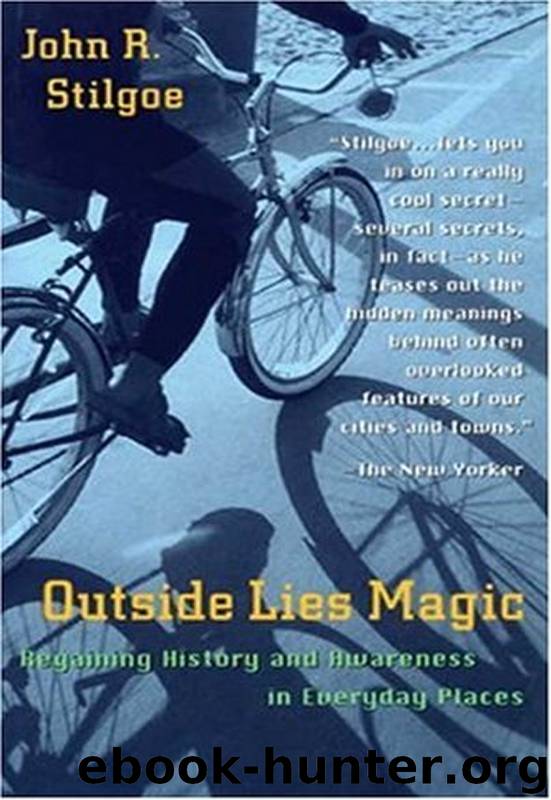Outside Lies Magic by John R. Stilgoe

Author:John R. Stilgoe
Language: eng
Format: mobi, epub
Publisher: Bloomsbury Publishing Plc
Published: 2009-07-16T04:30:00+00:00
Six
Enclosures
EVERYWHERE THE EXPLORER MOVES, he or she discovers fences and slowly realizes that fences are the unmentioned high-tech device of the last years of the twentieth century. Fences fence out, and fences contain, but only the explorer paralleling them and occasionally pausing to scrutinize them sees the ruthlessly efficient divvying up of the country.
From the very first settlement, colonists struggled to keep cattle, hogs, and other livestock either secured inside pastures and paddocks or else securely outside cornfields, gardens, and other planted ground. From Pennsylvania northward, colonists fenced in livestock and elected hog reeves—a reeve is a gatherer—to capture wandering animals and intern them in outdoor pounds until owners paid fines. (While the ancient shire reeve is now contracted to sheriff, rural New Englanders still elect livestock reeves.) South of Pennsylvania, colonists enclosed crops against livestock permitted to wander anywhere else, to graze along roadsides, to roam deep into forest until rounded up by the slaves—literally the cowboys—and branded at central sites like the Cowpens, which gave its name to a Revolutionary War battlefield. Westward expansion moved the two attitudes into the Mississippi Basin and beyond, and brought newcomer neighbors into bitter disputes. Fencing acrimony helped start the Civil War, and in later decades in the Far West it divided northern-attitude farmers from southern-attitude ranchers, and now pits ranchers against retirees, ski-resort owners, even yuppies gentrifying mining towns.
Once railroad companies learned that full-grown bulls sometimes derailed trains, steel-and-wood locomotive cowcatchers notwithstanding, fences soon bordered every railroad corridor in the North and South. However, rural dirt roads away from New England, New York, and Ohio often lacked fences into the 1920s, forcing motorists into terrifying collisions with grazing horses and steers. Travelers on horseback and in wagons expected confrontations with wandering horses and pigs, but not until automobilists began colliding with valuable farm animals did state legislatures enact "herd laws," mandating that farmers fence in all their livestock. Decades later, at the start of the interstate highway era, the federal government mandated that the high-speed roads be fenced at public expense, especially where great herds of beef cattle might stray onto the roadway. Only in the 1960s, as the interstate highway reached across the plains, did New Mexico end its long-standing "free-range" tradition and accept the fences that bordered its new interstate highways, but even now motorists in Maine discover the horror of hitting moose and long-distance truckers in Idaho wreck their vehicles after striking bears. Most roads stand unfenced against intruders, animals or otherwise, but most motorists still presume farmers contain their livestock.
EXPLORERS IMMEDIATELY LEARN something about the astounding regionalism of traditional rural fences by walking or riding through countryside settled generations ago by pioneers from different eastern regions, pioneers whose descendants still maintain or at least tolerate fencing types dating to colonial experiments. New England stone walls evolved first as linear rock piles, the aftermath of clearing land of tree stumps and stones, and until the 1850s worked as fences only when topped with rails split from logs. Southern
Download
This site does not store any files on its server. We only index and link to content provided by other sites. Please contact the content providers to delete copyright contents if any and email us, we'll remove relevant links or contents immediately.
Nudge - Improving Decisions about Health, Wealth, and Happiness by Thaler Sunstein(6628)
iGen by Jean M. Twenge(4692)
The Fire Next Time by James Baldwin(4336)
Adulting by Kelly Williams Brown(3662)
The Sports Rules Book by Human Kinetics(3580)
The Hacking of the American Mind by Robert H. Lustig(3574)
The Ethical Slut by Janet W. Hardy(3494)
Captivate by Vanessa Van Edwards(3292)
Mummy Knew by Lisa James(3163)
In a Sunburned Country by Bill Bryson(2940)
Ants Among Elephants by Sujatha Gidla(2919)
The Worm at the Core by Sheldon Solomon(2910)
Suicide: A Study in Sociology by Emile Durkheim(2605)
The Slow Fix: Solve Problems, Work Smarter, and Live Better In a World Addicted to Speed by Carl Honore(2570)
Humans of New York by Brandon Stanton(2376)
Handbook of Forensic Sociology and Psychology by Stephen J. Morewitz & Mark L. Goldstein(2376)
Blackwell Companion to Sociology, The by Judith R. Blau(2313)
The Happy Hooker by Xaviera Hollander(2271)
Outliers by Malcolm Gladwell(2253)
